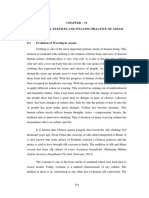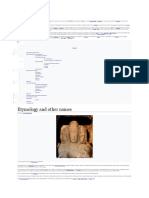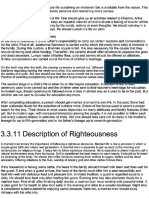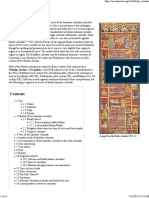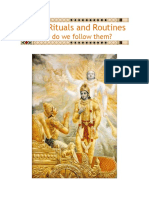Jagar Ritual
Jagar Ritual
Uploaded by
AAkancha SinghCopyright:
Available Formats
Jagar Ritual
Jagar Ritual
Uploaded by
AAkancha SinghCopyright
Available Formats
Share this document
Did you find this document useful?
Is this content inappropriate?
Copyright:
Available Formats
Jagar Ritual
Jagar Ritual
Uploaded by
AAkancha SinghCopyright:
Available Formats
Jagar Ritual
Jagar is a ritualized method of worshipping the 33 koti Devi Devta that is performed in Uttarakhand's
hills, both in Kumaon and Garhwal. Jagar is a rite in which gods and local deities are awakened from
their slumber and requested for blessings or cures. The rite is associated with the concept of divine
justice and is performed to offer penance for a crime or to seek divine justice for any injustice. The word
Jagar is derived from the Sanskrit root Jaga, which means "to awaken."
Music is the means by which the gods are summoned. The poet, or Jagariya, sings a ballad of the gods
with allusions to great epics such as the Mahabarata or Ramayana, which depict the adventures and
exploits of the god being invoked. Jagar singing has evolved over time into a much-loved art form,
whose practitioners are often lauded as living heritage.
These practices are part of Folk Hinduism, which has coexisted with orthodox Hinduism and is widely
practiced in the Himalayas. The harsh life in the Himalayas and daily sensitivity to the whims of nature
sparked a deep belief in paranormal activity and a plethora of folk gods, who were revered and
respected. Per village had its own deity, known as Bhumyal or Kshetrapal, who guarded its borders. Per
family has a Kul Devta or Kul Devi. There were also a plethora of other benevolent demigods and
goddesses who could praise humans, as well as evil spirits who could torture people.
These beliefs are related to shamanic customs used in ancient rituals all over the world. While most of
these deities have been forgotten or absorbed into monotheistic rites, Hinduism has strong kuladevata
traditions that have enabled the Jagar tradition to flourish in India and Nepal. The isolation of the
Kumaon and Garhwal due to the Himalayas, in particular, facilitated the rise of local religious practices,
which are now high in these regions alongside mainstream Hinduism.
Jagar ceremonies are classified into three categories. The first is the Dev Jagar, or deity invocation,
which normally involves local gods possessing the medium's body. The Bhut Jagar, or invocation of a
dead person's spirit or soul in the medium's body, is the second. Masan Puja is another less commonly
performed form.
Jagar is now regarded as a cultural and musical part of local heritage that must be preserved. The ritual
is still highly worshipped, especially in rural areas and in New Delhi. Since many Kumauni and Gadwali
live in Delhi and are unable to travel to villages for Jagar every year, they have started Jagar in Delhi.
You might also like
- Art Culture Current Affairs PDF E Book WWW - upscPDF.com 1 2Document74 pagesArt Culture Current Affairs PDF E Book WWW - upscPDF.com 1 2NomanNaseer100% (1)
- West Indian FolkloreDocument2 pagesWest Indian FolkloreRaven SynthxNo ratings yet
- ACCA F9 Mock Examination 2Document5 pagesACCA F9 Mock Examination 2daria0% (1)
- The Raji Tribe of Uttrakhand in GlobaliDocument6 pagesThe Raji Tribe of Uttrakhand in GlobaliPiru JohnNo ratings yet
- Rock Art Heritage of Pooja DunguriDocument3 pagesRock Art Heritage of Pooja DunguriSurendra HotaNo ratings yet
- Gandhamardan - A Treasure House of Medical PlantsDocument4 pagesGandhamardan - A Treasure House of Medical PlantsSurendra HotaNo ratings yet
- Nagaradhane: From Wikipedia, The Free EncyclopediaDocument3 pagesNagaradhane: From Wikipedia, The Free Encyclopediaanirudh.r.s.No ratings yet
- JAINpedia Themes Practices PadmāvatīDocument30 pagesJAINpedia Themes Practices Padmāvatīdrdivish50% (2)
- The Amazing Transformations of Arahant Theri UppalavannaDocument30 pagesThe Amazing Transformations of Arahant Theri UppalavannaTathālokā BhikkhunīNo ratings yet
- Vithala PDFDocument29 pagesVithala PDFkeshNo ratings yet
- 14 Chapter6 PDFDocument65 pages14 Chapter6 PDFJohn DoeNo ratings yet
- Caste System in Himachal PradeshDocument2 pagesCaste System in Himachal Pradeshsanjay vermaNo ratings yet
- BeliefsDocument11 pagesBeliefslinaNo ratings yet
- Durgapuja Odisha PDFDocument2 pagesDurgapuja Odisha PDFTushit NathNo ratings yet
- The Theory of The Sacrifice in The YajurvedaDocument6 pagesThe Theory of The Sacrifice in The YajurvedaSiarhej SankoNo ratings yet
- Origin of Indian Caste SystemDocument4 pagesOrigin of Indian Caste SystemMuktipadaBeheraNo ratings yet
- Chhatar - A Tradition of TraditionsDocument8 pagesChhatar - A Tradition of TraditionsHimansu Charan SadangiNo ratings yet
- 05 Introducation PDFDocument34 pages05 Introducation PDFTanay Gupta100% (1)
- ThesisDocument345 pagesThesisj..gNo ratings yet
- East IndiansDocument13 pagesEast IndiansDaniel DowdingNo ratings yet
- Docslide - Us Rasaravakalpaby Mira RoyDocument2 pagesDocslide - Us Rasaravakalpaby Mira Roymenow100% (1)
- Megalithic Culture of Vidarbha, Maharashtra: Inter-Regional RelationshipsDocument17 pagesMegalithic Culture of Vidarbha, Maharashtra: Inter-Regional RelationshipsDipali JoglekarNo ratings yet
- Review of Rajbali Pandey's Hindu Samskaras: Socio-Religious Study of The Hindu SacramentsDocument2 pagesReview of Rajbali Pandey's Hindu Samskaras: Socio-Religious Study of The Hindu Sacramentsrhapsodysinger100% (1)
- The Proposed Project in Athirappilly and The Kadar TribeDocument5 pagesThe Proposed Project in Athirappilly and The Kadar TribeIOSRjournalNo ratings yet
- Etymology and Other Names: Shiva (Document13 pagesEtymology and Other Names: Shiva (apsNo ratings yet
- 08 - Chapter 1 PDFDocument45 pages08 - Chapter 1 PDFThk100% (1)
- 18 Maha Puranas in English K2optDocument62 pages18 Maha Puranas in English K2optNim SudohNo ratings yet
- B.arch Dissertation - Praduman BajajDocument58 pagesB.arch Dissertation - Praduman BajajRiya BansalNo ratings yet
- T10361 PDFDocument235 pagesT10361 PDFFahad MemonNo ratings yet
- Formsofshiva PDFDocument23 pagesFormsofshiva PDFKritika RamchurnNo ratings yet
- 6 - Betel Leaf and NutDocument23 pages6 - Betel Leaf and Nutdurga7No ratings yet
- Bali Yatra: Reminiscence of Orissa's Maritime Glory (Prabhukalyan Mohapatra)Document3 pagesBali Yatra: Reminiscence of Orissa's Maritime Glory (Prabhukalyan Mohapatra)Srini KalyanaramanNo ratings yet
- KalahandiDocument45 pagesKalahandiBunty Mahananda100% (1)
- Post Mauryan Trends in Indian Art and Architecture (Indian Culture Series - NCERT)Document22 pagesPost Mauryan Trends in Indian Art and Architecture (Indian Culture Series - NCERT)Pankaj VatsaNo ratings yet
- The Salvation of The King in The Mahābhārata (Madeleine Biardeau)Document23 pagesThe Salvation of The King in The Mahābhārata (Madeleine Biardeau)Qian CaoNo ratings yet
- Hindu CalendarDocument18 pagesHindu CalendarSanjay Jayaratne100% (1)
- My Paper On CasteDocument7 pagesMy Paper On CasteLakhvinder SinghNo ratings yet
- Presentation 4Document5 pagesPresentation 4Anmol YadavNo ratings yet
- Sullivan - 1964 - Re-Examination Religion Indus CiviDocument12 pagesSullivan - 1964 - Re-Examination Religion Indus CivialastierNo ratings yet
- Aitareyabrahmana 04 HauguoftDocument440 pagesAitareyabrahmana 04 HauguoftVeena Mayuri100% (1)
- Bindu 451Document8 pagesBindu 451Francisco López-HerreraNo ratings yet
- Vedic Brahmanism in IndiaDocument9 pagesVedic Brahmanism in IndiaShivamNo ratings yet
- Nav Smarana 008333Document180 pagesNav Smarana 008333hero_2726No ratings yet
- Analogical Insights Unveiling The Role of Upamana Pramana in Ayurveda A ReviewDocument3 pagesAnalogical Insights Unveiling The Role of Upamana Pramana in Ayurveda A ReviewEditor IJTSRDNo ratings yet
- Culture of Arunachal PradeshDocument14 pagesCulture of Arunachal PradeshEshika chauhan100% (1)
- Concept and Evolution of Hindu MarriageDocument14 pagesConcept and Evolution of Hindu MarriageBHUMIKA PURINo ratings yet
- Dissertation - Final Draft 01Document63 pagesDissertation - Final Draft 01thejas.asNo ratings yet
- Origin of The Worship of Samalai PDFDocument18 pagesOrigin of The Worship of Samalai PDFBiswajit SatpathyNo ratings yet
- ShuddhadvaitamDocument5 pagesShuddhadvaitamsolaiacNo ratings yet
- Love, Violence, and The Aesthetics of Disgust Śaivas and Jains in MedievalDocument61 pagesLove, Violence, and The Aesthetics of Disgust Śaivas and Jains in MedievalSomebodythatyouusedto_knowNo ratings yet
- Paper On LagadhaDocument11 pagesPaper On LagadhaAmritanshu Verma100% (1)
- Chinese Folk ReligionDocument10 pagesChinese Folk ReligionHelio AraujoNo ratings yet
- Vallabha AcharyaDocument3 pagesVallabha AcharyalathacoolNo ratings yet
- Neo-Vaisnavism of Srimanta Sankardeva Whether A Religious Cult or A Self-Conciously Established Philosophical School With Special Reference To Vedanta PhilosophyDocument6 pagesNeo-Vaisnavism of Srimanta Sankardeva Whether A Religious Cult or A Self-Conciously Established Philosophical School With Special Reference To Vedanta PhilosophyIJBSS,ISSN:2319-2968No ratings yet
- Dravidian Kal and Hindu Gods of TimeDocument6 pagesDravidian Kal and Hindu Gods of Timehari18No ratings yet
- Details Around VasudevaDocument7 pagesDetails Around VasudevaHaridas VaryaNo ratings yet
- Lecture 4 Vedic CivilizationDocument27 pagesLecture 4 Vedic CivilizationNihal Singh VermaNo ratings yet
- Hindu Rituals and Routines: Why Do We Follow Them?Document21 pagesHindu Rituals and Routines: Why Do We Follow Them?Raghavendra RaghavendraNo ratings yet
- UST Global AutomDocument9 pagesUST Global AutomAAkancha SinghNo ratings yet
- Phool Dei FestivalDocument1 pagePhool Dei FestivalAAkancha SinghNo ratings yet
- Bissu Mela - Uttarakhand CultureDocument1 pageBissu Mela - Uttarakhand CultureAAkancha SinghNo ratings yet
- Harela FestivalDocument2 pagesHarela FestivalAAkancha SinghNo ratings yet
- Aipan Art of UttarakhandDocument2 pagesAipan Art of UttarakhandAAkancha SinghNo ratings yet
- Wings of Fire Notes PDFDocument11 pagesWings of Fire Notes PDFAAkancha SinghNo ratings yet
- Experimental Psychology For BADocument14 pagesExperimental Psychology For BAAAkancha SinghNo ratings yet
- New Doc 2019-12-03 21.04.14Document15 pagesNew Doc 2019-12-03 21.04.14AAkancha SinghNo ratings yet
- Fortuna VS PeopleDocument1 pageFortuna VS PeopleMrln VloriaNo ratings yet
- L4.1 - Production Equipment & Tooling SelectionDocument109 pagesL4.1 - Production Equipment & Tooling Selectiondawit gashuNo ratings yet
- PackagingDocument6 pagesPackagingJowjie TVNo ratings yet
- All chapter download Solution Manual for Cognition, 6/E Mark H. Ashcraft Gabriel A. RadvanskyDocument39 pagesAll chapter download Solution Manual for Cognition, 6/E Mark H. Ashcraft Gabriel A. Radvanskylithinlinaki100% (2)
- Deed of LeaseDocument2 pagesDeed of LeaseSHATHISH KUMARNo ratings yet
- Ahmed Taleb Mohamed Shebl Electrical EngineerDocument2 pagesAhmed Taleb Mohamed Shebl Electrical EngineerAhmed SaadNo ratings yet
- Maldives Honeymoon: With Return FlightDocument1 pageMaldives Honeymoon: With Return FlightelaNo ratings yet
- LTE Acronym ListDocument9 pagesLTE Acronym Listmansour14No ratings yet
- Barcoo Independent 110610Document8 pagesBarcoo Independent 110610barcooindependentNo ratings yet
- Unit 9. Cities of The Future: 4. A. Upgrade B. Presentation C. Description D. ConsumptionDocument14 pagesUnit 9. Cities of The Future: 4. A. Upgrade B. Presentation C. Description D. ConsumptionPham Minh NguyetNo ratings yet
- Sirim Standard: For Public CommentDocument15 pagesSirim Standard: For Public CommentcaptkhairulnizamNo ratings yet
- Object Oriented Programming Lab FileDocument32 pagesObject Oriented Programming Lab FileRitika PooniaNo ratings yet
- Multiplexer and De-Multiplexer: Rab Nawaz Khan JadoonDocument31 pagesMultiplexer and De-Multiplexer: Rab Nawaz Khan JadoonMuhammad ShahbazNo ratings yet
- Exploring The Influence of Social Media On Youth Mental Health A Comprehensive ExaminationDocument3 pagesExploring The Influence of Social Media On Youth Mental Health A Comprehensive ExaminationmrcyfavNo ratings yet
- UCAS Co Ordinator Applicant Information PackDocument8 pagesUCAS Co Ordinator Applicant Information PackJames BennettNo ratings yet
- How To Win Big by Winning SmallDocument3 pagesHow To Win Big by Winning SmallJoshua OwolabiNo ratings yet
- Haffmans CPT: CO Purity TesterDocument2 pagesHaffmans CPT: CO Purity Testermouh niaNo ratings yet
- Introduction To Development Studies PDFDocument102 pagesIntroduction To Development Studies PDFpop mayaNo ratings yet
- CCA3002 - FOG-AND-EDGE-COMPUTING - LT - 1.0 - 34 - Fog and Edge ComputingDocument3 pagesCCA3002 - FOG-AND-EDGE-COMPUTING - LT - 1.0 - 34 - Fog and Edge ComputingRevanta ChoudharyNo ratings yet
- 2016 Compiler ConstructionDocument3 pages2016 Compiler ConstructionAnonymous 4CQ2IDNo ratings yet
- 2.1 The Inner Structure of A Rule: Court."Document8 pages2.1 The Inner Structure of A Rule: Court."Stella BertilloNo ratings yet
- 7 Referencias BibliogaficasDocument26 pages7 Referencias BibliogaficasLenise CostaNo ratings yet
- Toucet ComplaintDocument9 pagesToucet ComplaintTerry McCoyNo ratings yet
- (PDF Download) Glencoe Short Stories 1 1st Edition Jeffrey D. Wilhelm Et Al Fulll ChapterDocument64 pages(PDF Download) Glencoe Short Stories 1 1st Edition Jeffrey D. Wilhelm Et Al Fulll Chapterxojavaasaaro100% (5)
- NBFC NotesDocument2 pagesNBFC NotesHemavathy Gunaseelan100% (1)
- Bizhub C368 - C308 - C258 (ZeusS) - Service Preparation Guide - Ver. 1.2Document57 pagesBizhub C368 - C308 - C258 (ZeusS) - Service Preparation Guide - Ver. 1.2Hritcu IulianNo ratings yet
- Ibps So 2017 Previous Year Question Paper - Reasoning Ability Af46e328 1Document33 pagesIbps So 2017 Previous Year Question Paper - Reasoning Ability Af46e328 1gokuvegetadbz04No ratings yet
- Language Acquisition GuideDocument118 pagesLanguage Acquisition GuideFrank Fernández100% (1)
- Constellations ABriefIntroductionDocument8 pagesConstellations ABriefIntroductionmellacrousnofNo ratings yet










